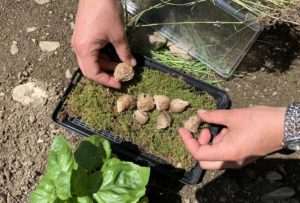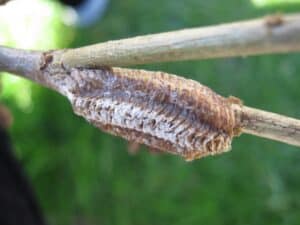Hello, fellow lovers of all things green. Lora asked how to determine whether the praying mantis egg sac in her yard was native or non-native. She’s concerned because she raises monarch and painted lady butterflies and a few toads she wishes to protect. The comment came after I shared the story of a neighbor purchasing mail-ordered praying mantises. Indeed, some mantises are beneficial, and some are bad.
The sad story of mail-order mantises

Sadly, Monica’s mail order was Chinese mantis egg sacks.
Upon returning the ladybug house to my kind neighbor, who offered her ladybugs to tend to my aphid dilemma (story link below), Monica showed me the nests of praying mantis she also mail-ordered. They were in a small aquarium-type container sitting in her vegetable garden and looked like toasted marshmallows. When you put them to your ear, you hear a crackling sound— I suspect the sound of baby mantises growing inside.

Native Carolina mantis: Photo Credit
Beatriz Moisset, CC BY-SA 4.0, via Wikimedia Commons
“Babies,” Monica texted a few weeks later, with a photo of the cute tiny praying mantis poised on her basil.
Invasive vs. Native Praying Mantis
Soon after the post, Michael Martinez, an Entomologist (who studies insects, spiders, scorpions, and other arthropods) wrote:
“You should destroy all Chinese mantis (Tenodera sinensis) egg cases. It’s an invasive species that eats beneficial insects and pests like all mantids. But the Chinese mantis is much larger than our native mantids and preys on hummingbirds, eating them alive. The Chinese mantis is also causing the decline of our native mantises, such as the much smaller Carolina mantis (Stagmomantis carolina), by preying on them. Let’s stop aiding the spread of the Chinese mantis by selling their egg cases.”
I had no idea that Monica unknowingly purchased egg cases of the Chinese mantis—an example of the importance of identifying species using scientific or botanical names because common names can be misleading. The Chinese mantis egg sacs, called an ootheca, are cube-shaped, like marshmallows, and straw-colored. The native Carolina mantis has a stretched-out, smoother surface with light and dark stripes.
Now that the leaves are down, spotting the non-native toasted marshmallow-like egg sacs is easier, so look for them. And you can use my dear old Mom’s technique of destroying pest nests by drowning them in a bucket of water, which sounds cruel, but at least they have not yet hatched.
Praying mantises’ behavior may overshadow their benefits.

Native Carolina mantis: Photo by
Kaldari, Public domain, via Wikimedia Commons
It’s remarkable how a newborn praying mantis looks like a miniature grownup, unlike most critters. However, as I learn more about this fascinating creature, the queasiness over their behavior seems to overshadow the benefits they serve in the garden.
Maybe you’ve heard how females often eat the heads of the males after mating. They then lay their egg sacs on twigs, fences, siding, or other structures before they die in the fall after the first frost. Females lay about 300 eggs in frothy liquid excrement that then solidifies. Only a fifth of the eggs will survive into adulthood.
If you purchase native mantis nests to hatch at home, it’s best to buy them when it is warm enough to release them; otherwise, they emerge famished and are known to eat one another if they can’t find food quickly.
Praying mantises eat pests and beneficial bugs.
While the native Carolina praying mantises are beneficial in controlling pests such as mosquitoes, flies, and crickets, they also eat beneficial bugs. So, it’s best to identify your target pests before considering them as biological controls.
Populations of the native praying mantis are lessening due to introduced species such as the invasive Chinese mantis. Tenodera sinensis, native to Asia, are sold as pets. They say a nursery person near Philadelphia mistakenly introduced them here in 1896. They’re over four inches long compared to the native species, which only grow to two to two-and-a-half inches.
Non-native Chinese mantis harmful.

Monica’s newly hatched Chinese Praying Mantis
The native and non-native praying mantis vary from greyish to brownish to green, adjusting with each molting to blend with their environment. The Chinese mantis shares the same appetite as the native ones but also feeds on monarch butterflies, small reptiles such as toads and little frogs, and even hummingbirds, as Michael shared. They also eat the native praying mantis. Then there’s the European mantis (Mantis religiosa), a bit smaller than the Chinese mantis brought here to feed on the gypsy moth caterpillar. They, too, are now considered invasive.
It’s hard to imagine that sources sell non-native praying mantis as biological controls. So be sure to shop for praying mantis native to your area using the scientific name. Or, perhaps better yet, let Mother Nature decide if they should be in your garden.
Garden Dilemmas? AskMaryStone@gmail.com (and now on your favorite Podcast App.
Click through to the previous column about Monica’sBeneficial Ladybugs.
There’s more to the story, including a section of my forthcoming book, The Lesson of the Leaf in the Garden Dilemmas Podcast:
Link to New Jersey Audobon’s column on Praying Mantis – Indiscriminate Predator and an excellent photo comparing egg sacks.



Mary,
You should destroy all those Chinese mantis (Tenodera sinensis) eggcases its an invasive species that eats the beneficials as well as the pests like all mantids. But the Chinese mantis is much larger than our native mantids and also preys on hummingbirds eats them alive ! google some graphic videos on this subject if you can stand to watch !the Chinese mantis is also causing the decline of our native mantises such as the much smaller Carolina mantis (Stagmomantis carolina )by preying on them. lets stop aiding the spread of the chinese mantis by selling their eggcases, Michael Martinez Entomolgist.
You are so right, Michael! It’s especially powerful to hear the recommendation from an expert such as yourself. Thank you for sharing your expertise. and, for reading my column, Mary Stone
Michael, What is the preferred method to destroy the egg sack? I had no idea what I have were the Chinese ones, let alone that they were invasive. We’ve had as many as 3 egg sacks at a time, but this year I’ve only seen one and it hasn’t hatched yet. I’m in Ohio, zone 6, if that matters.
Hello Molly, I hadn’t known that there was invasive mantis until digging into the dilemma. My dear old Mom, who gave me my garden start, would drown them in a bucket of water. Thanks for reading my column, Mary
I believe I have a nest of Chinese mantises that hatched. I had them in a jar and had poked holes in the lid but put a paper towel over it and screwed the lid on. I noticed today that I have a bazillion of them that hatched what should I do with them? It’s cold out now should I just let them to?
Hello Colleen, Invasive species experts would likely suggest you destroy them, but I’ll admit, I don’t have the heart to do that. But certainly, you’ll need to release them (they can’t live in your home!). And if it’s too cold for them outside, Mother Nature will do her job. Best of luck! Thanks for reading my column, Mary
How do I know if this egg sack that showed up in my Mn yard is a native or non-native? This concerns me because I raise Monarch and Painted Lady butterflies and have a few toads in my yard that I wish to protect.
Hi Lora, The invasive species egg sacks (also called an ootheca) look like toasted marshmallows to me (cube-shaped, ping-pong ball-sized, the color of straw). The native Carolina mantis has a smoother surface and is stretched out with light and dark stripes.
Here’s a link to an excellent photo comparing the egg sacks.
https://brooklynbridgepark.org/wp-content/uploads/2024/02/Brooklyn-Bridge-Park-Management-Guide-Mantis-Guide.pdf
Thank you for commenting. Your question helped me and will help others identify the invasive praying mantis, Mary Stone
I know that there are a lot of invasive species, both on land and in the water, plant and animal. This is the first time that I have heard of a invasive mantis. Did you know that there are invasive earth worms, and invasive crayfish taking over our native species now. When and how can we stop the invasion? I enjoy reading your articles.
Thank you for your comment, Barry; I know about the earthworms and posted a story about it a while back – here’s the link: https://askmarystone.com/good-for-the-garden-not-for-the-woods/
I had not heard about invasive crayfish, though. We have much to learn in the garden of life! Hopefully, destroying the invasive mantis nests will help. But how to stop the worms and crayfish? Perhaps Mother Nature will step in and make corrections. Thank you for your kind words and for taking the time to post a comment. It means so much, Mary
I loved this post, Mary! Praying mantises have always fascinated me, but I wasn’t sure about their role in the garden. Your insights are so helpful! I’m excited to see how I can encourage these beneficial creatures while keeping my garden thriving. Thank you for clarifying their impact!
You are very welcome! Thank you for reading the post and taking the time to comment. It means so much to hear from folks who are nurturing nature. Thank you for being one of them, Mary